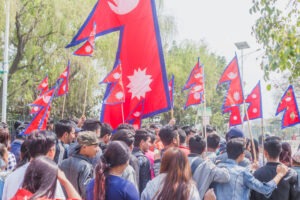Violent protests against a government-imposed social media ban in Nepal escalated dramatically, resulting in at least 51 deaths and over 1,300 injuries, and forcing Prime Minister KP Sharma Oli to resign from office. The demonstrations, which began as youth-led opposition to blocked platforms including Facebook, YouTube, and Instagram, transformed into a nationwide uprising that has shaken the foundations of Nepal’s democracy.
The unrest began on Monday, September 8, when thousands of predominantly young demonstrators took to the streets of Kathmandu after the Oli government blocked 26 social media platforms for failing to register with Nepali authorities. What started as protests against the digital restrictions quickly evolved into broader demonstrations against corruption, nepotism, and soaring unemployment rates affecting the country’s youth population.
Police opened fire on protesters who attempted to storm the parliament building, leading to the deadliest crackdown since Nepal’s 2006 people’s movement. Nepal’s Minister for Communication Prithvi Subba confirmed that police deployed water cannons, batons, live fire, and rubber bullets during the confrontations. The violence marked a significant escalation from peaceful demonstrations to deadly street battles between security forces and protesters.
The protests took an increasingly violent turn as demonstrators set fire to government buildings and stormed the residences of political leaders. Five-time Prime Minister and Nepali Congress chief Sher Bahadur Deuba and his wife, Foreign Minister Arzu Rana Deuba, were reportedly beaten and sustained injuries before party workers evacuated them to safety. In another tragic incident, protesters set fire to the residence of former Prime Minister Jhala Nath Khanal in Dallu, where his wife Rajyalaxmi Chitrakar was trapped inside and later died from severe burn injuries.
The violence spread throughout Kathmandu Valley as protesters targeted multiple political figures’ homes. Oli’s private residence in Balkot was set ablaze just hours before his resignation, while the homes of President Ram Chandra Paudel and former Prime Minister Pushpa Kamal Dahal also came under attack. Eyewitnesses reported widespread arson, looting, and mob violence as police struggled to maintain control of the situation.
President Paudel accepted Oli’s resignation and appointed him to lead a caretaker government until a new administration was later formed. In a public appeal, Paudel urged protesters to end the violence and pursue dialogue, stating that “Stop the ban on social media, stop corruption not social media.” The president emphasized that in a democracy, citizens’ demands must be resolved through negotiation rather than destruction.
The Nepali Army, led by Chief of Army Staff General Ashok Raj Sigdel, was deployed to secure key installations, including Kathmandu airport and Singha Durbar, the government’s central secretariat. In a televised address, General Sigdel offered condolences to the families of the deceased while warning of strict action against vandalism and looting. A curfew remains in place across parts of the capital, with military forces maintaining control of law and order.
Although the social media ban was lifted on Tuesday, protests continued as anger mounted over the deaths and decades of political dysfunction. The demonstrators, mostly in their 20s and early 30s, rallied against what they term “nepo kids” – children of political elites who flaunt wealth while ordinary youth struggle with joblessness. According to World Bank data, Nepal’s youth unemployment stood at 20-22 percent last year, with more than 2,000 Nepalis leaving daily to seek work abroad.
The government’s initial action targeted social media platforms for not complying with registration deadlines. Officials argued that regulation was necessary to prevent the spread of fake news and internet fraud, claiming companies had been given repeated notice to register officially but failed to act. However, critics condemned the measure as censorship and an attack on freedom of expression. Platforms such as TikTok and Viber, which had registered with Nepali authorities, continued operating without disruption.
The violence marks a dangerous shift from Nepal’s previous people’s movements, which had clear leadership and political goals. Analysts warn that the amorphous, leaderless nature of these protests could push the country into deeper instability, potentially creating space for anti-system forces such as monarchists or hardline nationalists to gain influence. The protests echo similar youth-led uprisings across South Asia, from Bangladesh’s student movement to Sri Lanka’s Aragalaya demonstrations.
International borders have been closed, and flights remain suspended as the government maintains its security posture.
The interim Prime Minister is Sushila Karki, the former Chief Justice. She was sworn in on September 12, 2025. Elections are scheduled for March 5, 2026. The Parliament has been dissolved.
Curfews have been lifted in parts of Kathmandu as calm begins to return.

